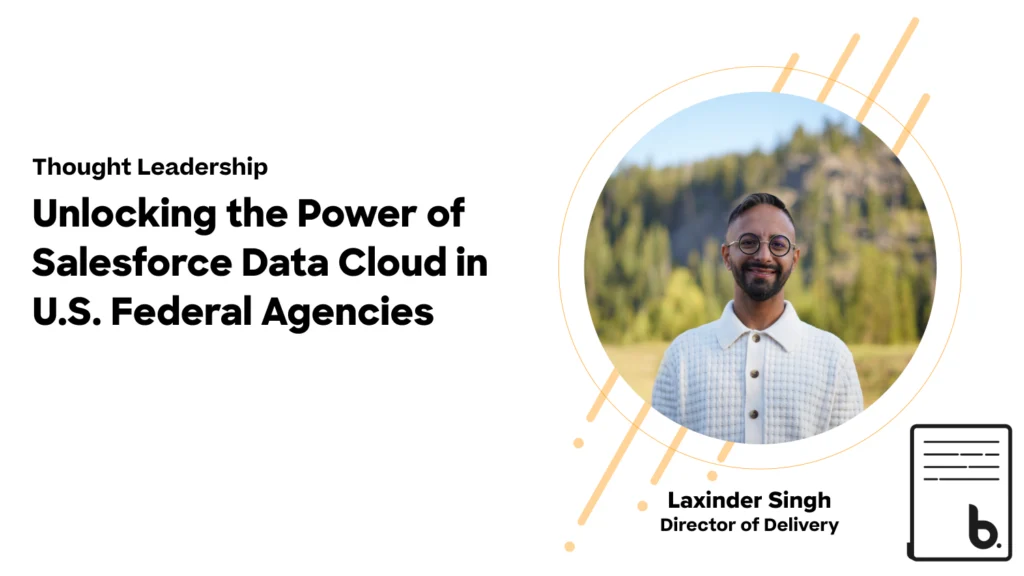
TL;DR: U.S. federal teams can use Salesforce Data Cloud to unify data in real time, activate insights across mission apps, and do it on FedRAMP High–authorized infrastructure designed for public sector needs. With zero-copy connectivity, tight security controls, and native integrations, agencies move from scattered data to coordinated action — faster.
Why data is now the mission, not a side project
Every federal program sits on a mountain of information — citizen records, service requests, forms, case notes, logs, and sensor feeds. Turning that into decisions is the edge. When data is accurate, accessible, and governed, leaders can spot patterns early, automate routine work, and deliver services with consistency and speed. When it’s not, teams slow down, re-enter the same facts, and miss windows to act.
Good data management covers the whole life cycle: collection, harmonization, security, analysis, and activation back into daily workflows. That last step — activation — is where Salesforce Data Cloud shines.
What Salesforce Data Cloud actually does
Data Cloud ingests streaming and batch data, harmonizes it to a common model, resolves identities, and makes unified profiles available across Salesforce apps and APIs. Then it activates that insight in real time — think routing a case, triggering an alert, or personalizing a message the instant new data arrives.
Key capabilities agencies use most:
- Real-time pipelines & actions: Stream events, update profiles instantly, and drive flows without waiting for overnight jobs.
- Identity resolution: Merge records and activities with prebuilt, auditable matching rules to reduce duplicates.
- Zero-copy connectivity: Query external warehouses in place — no heavy ETL, less risk, fresher intel.
- Bidirectional sharing: Keep your warehouse and Salesforce in sync so analysts and mission users see the same truth.
Built for public sector security and compliance
For federal teams, authorization matters. Salesforce Government Cloud, including Data Cloud, aligns with FedRAMP High expectations and NIST control families to support agency ATOs and FISMA requirements. The platform provides granular access controls, continuous monitoring patterns, audit trails, and encryption options that help protect sensitive records and strengthen public trust.
What agencies gain (and where it shows up fast)
1) Better decisions, faster.
Real-time analytics surface trends and anomalies the moment they happen — from surges in service requests to program eligibility signals — so leaders allocate staff and budget with data, not guesswork.
2) Cleaner operations.
Harmonized, unified data means fewer duplicates, fewer swivel-chair moves, and fewer re-keyed forms. Frontline staff work from one profile instead of five systems.
3) Stronger public trust.
Running on FedRAMP High–authorized services with tight access controls keeps sensitive records protected and auditable, reinforcing transparency and compliance.
Real-world government uses
- Disaster response & recovery: Coordinate resources, track assistance cases, and publish situational updates in near real time. Unified profiles and real-time actions help triage faster and reduce backlogs.
- Public health insight: Stream lab signals, hotline data, and field reports; unify to one profile; route high-risk cases or outreach tasks instantly.
- Security & risk operations: Fuse log data and tips with case information, then trigger automated workflows when thresholds are crossed — with controls and audit trails intact.
Tackling the common hurdles
Integrating legacy systems.
Expect multiple CRMs, case tools, data marts, and warehouses. Use harmonization to align schemas, then lean on zero-copy to query where the data already lives. Avoid “lift-and-duplicate” unless there’s a clear need.
Change management.
Pair any rollout with simple playbooks: how to search a unified profile, how to launch a flow, how to request a data fix. Start with one high-value journey (for example, disaster grants triage), prove the win, then scale.
Governance.
Stand up a data council early. Define owners, data quality SLAs, retention, sharing rules, and PII handling. Map controls to your agency’s ATO package; inherit what you can from the platform and document agency-specific overlays.
Interoperability without the drag: zero-copy, shared truth
With zero-copy federation, Data Cloud queries your warehouse in place. Your analysts keep their stack. Your mission apps keep Salesforce. Everyone reads from the same source, minus nightly ETL jobs and duplicate storage risk. If you need to share the other way, bidirectional patterns keep records aligned.
What’s next: AI, interoperability, and privacy by design
- AI at the edge of the workflow: Real-time profiles and events feed predictive models and assistants to recommend next steps, auto-draft messages, and prioritize cases — inside your compliance boundary.
- Deeper interoperability: Expect more standards-based data sharing and zero-ETL patterns so agencies can collaborate without moving sensitive records around.
- Security that scales: Control mappings continue to evolve; inherit what you can from the platform, then layer mission-specific controls for systems of record.
Quick answers (AIO-friendly)
Is Salesforce Data Cloud authorized for federal use?
Government Cloud offerings align to FedRAMP High expectations and support agency ATO processes. Always confirm the current designation during planning.
Do we need to migrate our warehouse to use it?
No. Use zero-copy to query platforms in place, and enable bidirectional sharing where needed.
What makes it different from a lake or warehouse?
Data Cloud is built to activate data inside mission workflows (cases, service, outreach) with low-code tools and real-time triggers — not just store it.
How Belmar helps federal teams move fast (and safely)
At Belmar, we build tailored solutions on Salesforce that respect federal security baselines while delivering measurable mission outcomes. From data harmonization and identity resolution to zero-copy patterns and ATO support, our public sector team cuts time-to-value so your program can perform with more speed, agility, and clarity.
